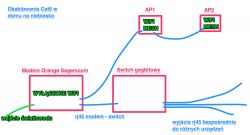Hi,
I want to set up a mesh network. I have an Orange Sagemcom Funbox 3.0 Fast 5656 PP modem. I bought a Smart Wi-Fi Box from them, but it works so badly that even a voice call on Skype is impossible (which is strange, because the speeds are acceptable, usually 200-500mpbs download, about 300mpbs upload, ping 5ms, jitter 0, packet loss 0). In addition, the range of this Smart Wi-Fi Box is terrible - in the room directly behind the wall on which it hangs, the speed drops by about 50%.
Therefore, I want to give up the Smart Wi-Fi Box. I also want to completely disable wifi on Sagemcom (the modem is too far away anyway) and create a completely separate wifi network, based on my own devices, simply connected to Sagemcom. I suspect I will have 2 access points. The problem is that the electricians routed the cable from the modem to the upstairs corridor (let's call Access Point1) and from there, not from the modem, down the corridor to the ground floor (Access Point2). Therefore, I currently have these RJ's bridged on the first floor, and the Smart Wi-Fi Box is located on the ground floor, i.e. in Access Point 2, because we use the Internet more here.
I want to buy 2 devices that will create a mesh network:
- device1 (AP1) will be connected with a cable to the Orange modem and placed in the place of Access Point1 - it has a direct connection to the Internet. It is supposed to emit WiFi 2.4/5GHz mesh.
- device2 (AP2) will be connected with a cable to AP1. It is supposed to emit WiFi 2.4/5GHz mesh.
The problem for me is the first device. First of all, from what I've read, the mesh network is decentralized with one device connected to the internet, and in my case that device will be another (Orange) device. Secondly, it must have a switch property, because it must give me a signal to the other device.
PS1. If the cost of such a strange solution is much higher than the standard one, we will dig into the walls and add an additional cable from the modem to Access Point2, although out of laziness we would prefer to avoid digging, plastering and painting half the house on the way.
PS2. At home, all cables are cat 6, so there should be no problems with gigabit transmission. The sockets are also gigabit.
I am asking for help in choosing such devices so that this network can be implemented. I'm not interested in repeaters, because they create separate duplicate wifi networks with the same ssid and disconnect the session when switching between them.
Illustrative drawing for description:

I want to set up a mesh network. I have an Orange Sagemcom Funbox 3.0 Fast 5656 PP modem. I bought a Smart Wi-Fi Box from them, but it works so badly that even a voice call on Skype is impossible (which is strange, because the speeds are acceptable, usually 200-500mpbs download, about 300mpbs upload, ping 5ms, jitter 0, packet loss 0). In addition, the range of this Smart Wi-Fi Box is terrible - in the room directly behind the wall on which it hangs, the speed drops by about 50%.
Therefore, I want to give up the Smart Wi-Fi Box. I also want to completely disable wifi on Sagemcom (the modem is too far away anyway) and create a completely separate wifi network, based on my own devices, simply connected to Sagemcom. I suspect I will have 2 access points. The problem is that the electricians routed the cable from the modem to the upstairs corridor (let's call Access Point1) and from there, not from the modem, down the corridor to the ground floor (Access Point2). Therefore, I currently have these RJ's bridged on the first floor, and the Smart Wi-Fi Box is located on the ground floor, i.e. in Access Point 2, because we use the Internet more here.
I want to buy 2 devices that will create a mesh network:
- device1 (AP1) will be connected with a cable to the Orange modem and placed in the place of Access Point1 - it has a direct connection to the Internet. It is supposed to emit WiFi 2.4/5GHz mesh.
- device2 (AP2) will be connected with a cable to AP1. It is supposed to emit WiFi 2.4/5GHz mesh.
The problem for me is the first device. First of all, from what I've read, the mesh network is decentralized with one device connected to the internet, and in my case that device will be another (Orange) device. Secondly, it must have a switch property, because it must give me a signal to the other device.
PS1. If the cost of such a strange solution is much higher than the standard one, we will dig into the walls and add an additional cable from the modem to Access Point2, although out of laziness we would prefer to avoid digging, plastering and painting half the house on the way.
PS2. At home, all cables are cat 6, so there should be no problems with gigabit transmission. The sockets are also gigabit.
I am asking for help in choosing such devices so that this network can be implemented. I'm not interested in repeaters, because they create separate duplicate wifi networks with the same ssid and disconnect the session when switching between them.
Illustrative drawing for description:



